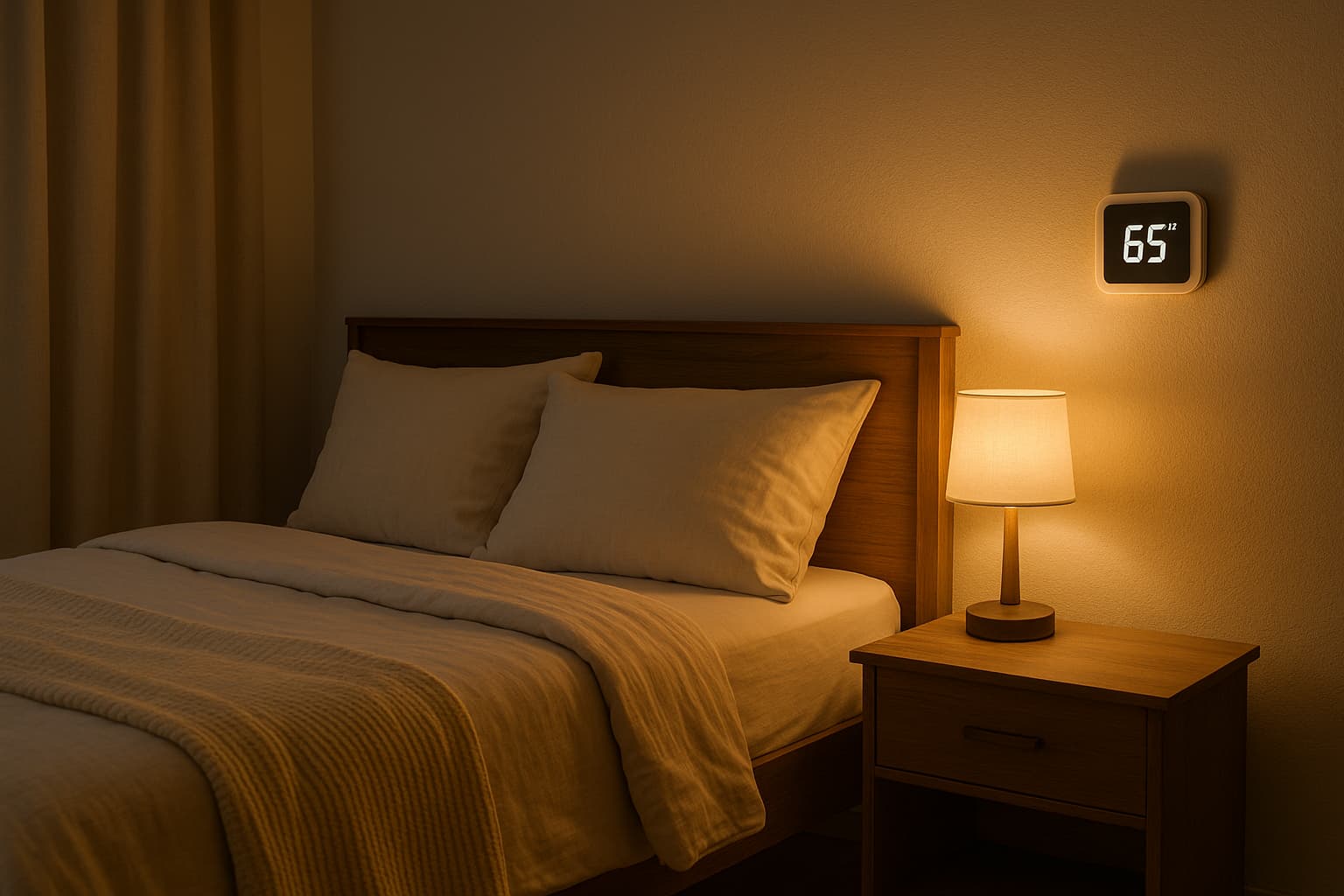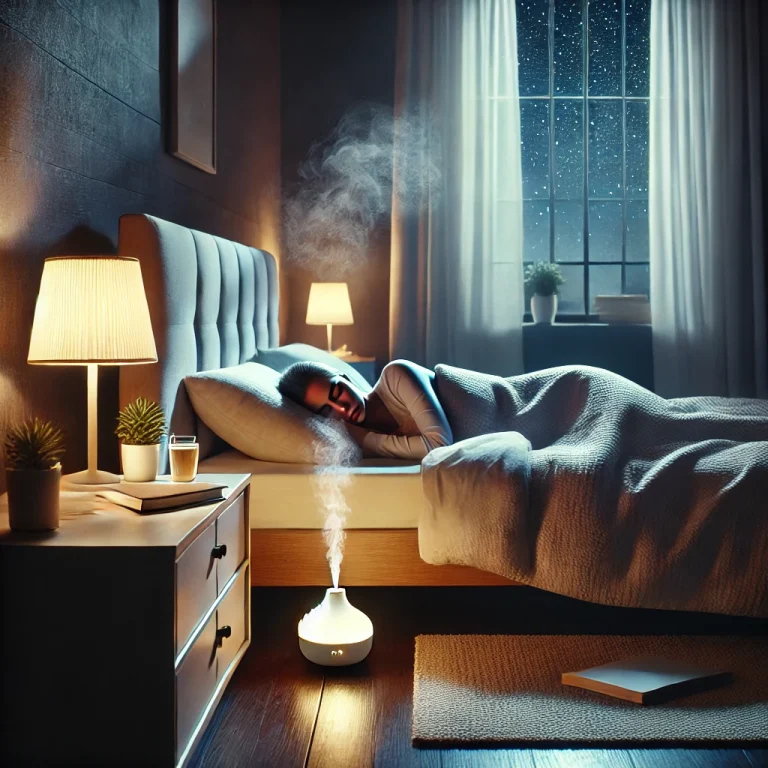The Best Bedroom Temperature for Sleep — Backed by Science
Ever wake up in the middle of the night feeling too hot, too cold, or just oddly restless? You’re not imagining it — your bedroom temperature plays a major role in how deeply you sleep. In fact, researchers have found that temperature may influence sleep quality just as much as noise or light exposure.
Finding the best bedroom temperature for sleep isn’t only about comfort. It’s about helping your body maintain its natural rhythm — the rise and fall of core temperature that signals when it’s time to rest. If your room runs too warm, your body struggles to cool down, making deep, restorative sleep harder to reach. Too cold, and you may tense up or wake often through the night.
In this article, we’ll explore how temperature affects your sleep cycle, what science says about the ideal range, and practical ways to cool your environment for deeper rest. By the end, you’ll know exactly how to fine-tune your room for your best night’s sleep yet.
How Temperature Affects Deep Sleep and the Body’s Natural Rhythm

Your body runs on a 24-hour internal clock — the circadian rhythm — that tells you when to wake, wind down, and sleep. One of the key signals in that rhythm is core body temperature. As evening approaches, your internal temperature naturally drops by about one to two degrees Fahrenheit, prompting the brain to release melatonin, the hormone that helps you fall asleep.
If your bedroom is too warm, that cooling process is disrupted. Instead of gliding into deep, restorative sleep, you’re more likely to toss, turn, or stay stuck in lighter stages of rest. A cooler environment, on the other hand, helps your body slow its heart rate and metabolism — ideal conditions for deep, unbroken sleep.
To support that natural drop, keep your sleep space aligned with your body’s rhythm. Most sleep experts suggest maintaining your bedroom in the low to mid-60s Fahrenheit (around 15–19°C). This range lets your body cool naturally without feeling chilled, improving both sleep quality and duration.
Research published in journals such as Sleep Medicine Reviews shows that cooler environments not only make it easier to fall asleep but also extend time spent in slow-wave sleep, the most restorative phase. Simply put, setting your room temperature right is one of the easiest, most science-backed ways to upgrade your nightly recovery.
The Best Bedroom Temperature for Sleep (and Why It Matters)
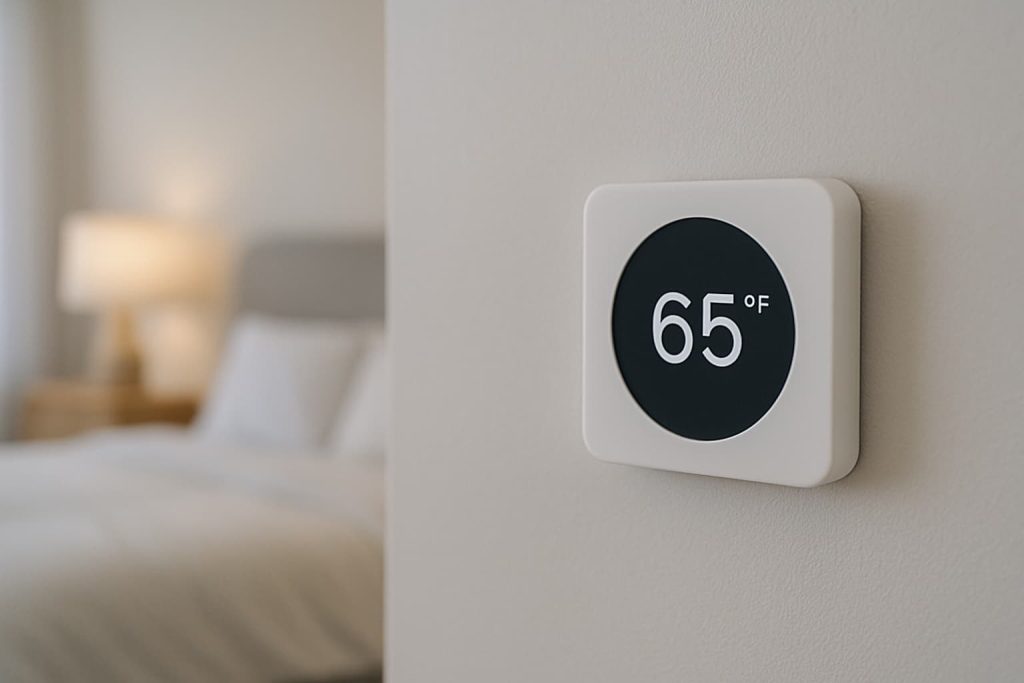
The ideal bedroom temperature for sleep isn’t an arbitrary number — it’s rooted in how your body regulates heat overnight. As you cycle through light, deep, and REM sleep, your core temperature continues to fall until early morning. When your room supports that natural cooling process, you’re able to move through these stages smoothly and wake up genuinely refreshed.
If your environment is too warm, your body has to work harder to stay cool, often disrupting deep sleep and shortening your most restorative phases. Conversely, when your room is too cold, you may wake repeatedly as your body tenses to conserve heat. Both extremes pull you out of deep rest, leading to grogginess and fatigue the next day.
Most adults find their best sleep occurs in a slightly cool environment — around 60°F to 67°F (15–19°C). Within this range, your body conserves less energy on temperature regulation and devotes more to recovery, tissue repair, and hormone balance.
If you’re not sure where your sweet spot lies, start small. Adjust your thermostat one or two degrees each night and track how easily you fall asleep, how often you wake, and how rested you feel in the morning. Over a week or two, you’ll find the setting that matches your body’s rhythm naturally.
Sleep researchers note that cooler conditions also promote the release of growth hormone, essential for tissue repair and overnight recovery. This makes proper temperature control especially valuable for athletes, people managing stress, and anyone who wants to maximize restorative rest.
Simply put, the right room temperature doesn’t just make sleep more comfortable — it helps your body heal, rebuild, and prepare for the day ahead.
How to Cool Your Bedroom for Better Sleep
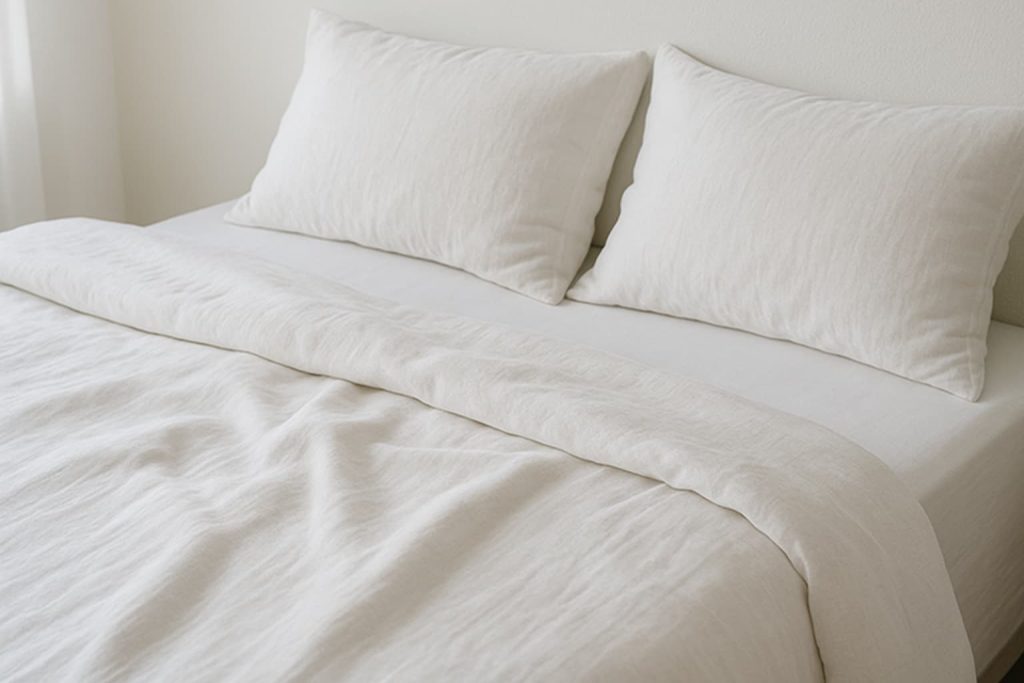
Even when your thermostat is set correctly, your bedroom environment can still trap heat and prevent your body from cooling naturally. Bedding, furniture placement, and even how sunlight enters the room all influence how comfortably you sleep. The goal isn’t just a lower number on the thermostat — it’s steady airflow, breathable materials, and a setup that supports your body’s nightly temperature drop.
Start with small, realistic adjustments:
- Switch to breathable fabrics. Cotton, bamboo, and linen allow air to circulate and wick away moisture.
- Choose a lighter comforter. Ditch thick duvets for quilts or summer-weight blankets that trap less heat.
- Improve air movement. Use a ceiling or oscillating fan to circulate cool air, or crack a window to release trapped warmth.
- Keep heat out during the day. Close curtains or blinds on sun-facing windows to prevent temperature buildup.
- Cool down before bed. A short lukewarm shower or cool compress on the back of your neck can quickly lower your core temperature.
Sleep specialists often recommend layering light blankets instead of one heavy comforter. This gives you more control overnight — you can adjust warmth without touching the thermostat, making it especially useful for couples with different temperature preferences.
You don’t need expensive cooling gadgets or a complete bedroom makeover to notice a difference. A few mindful tweaks to airflow and fabrics can transform your room into a cooler, more sleep-friendly space that supports deep, uninterrupted rest.
Related: Should You Shower Before Bed for Better Sleep
When Temperature Issues Disrupt Your Sleep (and What to Watch For)

Even a small change in room temperature can have a surprising impact on how deeply you rest. When your sleep environment gets too warm, your body has to work harder to stay cool — a process that triggers more movement, sweating, and light sleep. This constant effort prevents your body from entering slow-wave sleep, the stage responsible for physical recovery, immune support, and memory processing.
Overheating at night often leads to micro-awakenings, those brief moments when your brain partially wakes up without you realizing it. You might not remember them, but they leave you feeling groggy and unrefreshed in the morning. High humidity, poor airflow, or heavy bedding can make the problem worse by trapping heat around your body.
If you regularly wake up sweaty, tangled in sheets, or feeling drained despite a full night’s rest, your room temperature may be the culprit. Keep an eye out for other patterns too — vivid dreams, restlessness, or frequent tossing can all signal your sleep is being disrupted by heat.
In some cases, temperature sensitivity isn’t just environmental. Hormonal changes, thyroid issues, or menopause can alter how your body regulates warmth. If you’ve optimized your room setup but still struggle with night sweats or overheating, it may be worth speaking with a doctor or sleep specialist. Identifying and addressing the underlying cause can restore both comfort and consistency to your nights.
How to Find Your Perfect Sleep Temperature
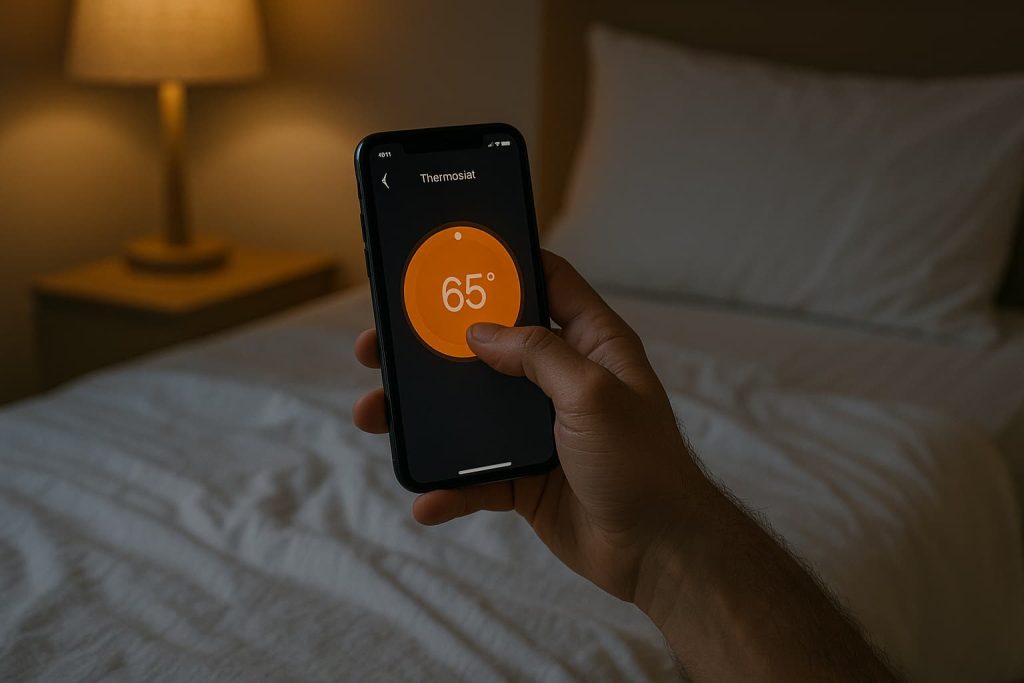
While studies suggest most people sleep best in rooms kept between 60°F and 67°F (15–19°C), the ideal temperature is ultimately personal. Factors like age, metabolism, bedding, and even hormones affect how warm or cool you feel at night. Women going through menopause or individuals with faster metabolisms may need cooler conditions, while older adults often prefer a touch more warmth to stay comfortable.
Your body also has what scientists call a “set point” — the internal temperature it maintains for optimal rest. This varies slightly from person to person, which is why your friend’s perfect 64°F might leave you shivering. The key is finding the number that aligns with your own rhythm.
To do that, experiment gradually. Start around 65°F and adjust the thermostat by one or two degrees each night. Note how quickly you fall asleep, how many times you wake, and how refreshed you feel in the morning. Over a week or two, patterns will emerge, revealing your personal comfort zone.
If you use a sleep tracking app or wearable, pay attention to deep sleep duration and body temperature data — they’ll often confirm what your body already senses. Pair these adjustments with other calming pre-bed habits, like dimming lights and limiting screen time, to help your body recognize it’s time to rest.
Once you find your sweet spot, stay consistent. Maintaining a stable temperature each night reinforces your circadian rhythm, leading to smoother transitions into deep sleep and more energized mornings.
You May Like:
- 10 Healthy Sleep Habits for Deeper Rest and Energy
- 7 Herbal Teas That Help You Sleep Naturally
- 15 Proven Hacks to Fall Asleep Faster
Conclusion: Small Temperature Tweaks, Big Sleep Rewards
A truly restful night starts with more than a dark room or the right pillow — it’s about creating an environment that supports your body’s natural rhythm. Finding the best bedroom temperature for sleep allows your core temperature to drop smoothly, signals your brain to release melatonin, and helps you reach the deep, restorative stages where real recovery happens.
The beauty is that this doesn’t require dramatic changes. Adjusting your thermostat by just a few degrees, choosing breathable bedding, or improving airflow can make a noticeable difference within days. Once your body finds its ideal range, you’ll likely fall asleep faster, wake less often, and feel more alert in the morning.
With a few small, mindful tweaks, your bedroom can become the calm, restorative space your body craves. If you’re ready to improve your sleep even further, explore [10 Quick Fixes to Sleep Better Tonight] for simple strategies you can try this evening — and start waking up refreshed, not restless.
❓ FAQs About Bedroom Temperature and Sleep
What is the best temperature for a bedroom at night?
Sleep experts recommend keeping your bedroom between 60°F and 67°F (15–19°C) for optimal rest. This range supports your body’s natural cooling process, helping you fall asleep faster and stay in deep, restorative sleep. Cooler air signals your body it’s time to unwind for the night.
What is the best bedroom temperature for sleep?
The best bedroom temperature for sleep is typically around 65°F (18°C) — the midpoint of the ideal range. It allows your body to drop its core temperature efficiently, improving sleep onset and quality. Small variations are normal, so experiment within a few degrees to find what feels most natural for you.
Does a hot bedroom really affect deep sleep?
Yes. When your room is too warm, your body struggles to cool down. This interferes with melatonin production and increases night-time awakenings. Over time, it reduces slow-wave (deep) sleep — the stage that helps restore your muscles, balance hormones, and consolidate memories.
How can I cool my bedroom naturally?
Simple tweaks can make a big difference: use breathable bedding, keep curtains closed during the day, and promote airflow with a fan or open window. Taking a lukewarm shower before bed also helps lower core temperature, priming your body for better sleep.
What if I get too cold at night?
If you’re prone to feeling chilly, layer lightweight blankets instead of using one heavy comforter. This lets you adjust warmth easily without overheating. Wearing breathable socks or keeping a warm water bottle near your feet can also keep you cozy without affecting room temperature.
Can temperature problems be a sign of a health issue?
Sometimes, yes. Persistent overheating, chills, or night sweats may point to hormonal shifts, thyroid imbalances, or other underlying conditions. If environmental adjustments don’t help, talk to a healthcare professional or sleep specialist for further evaluation.

